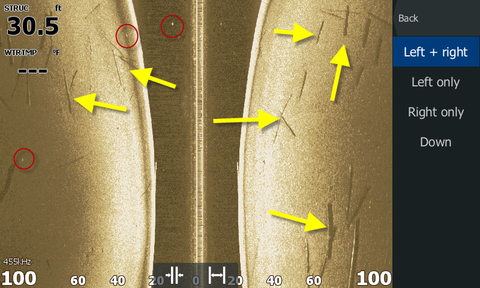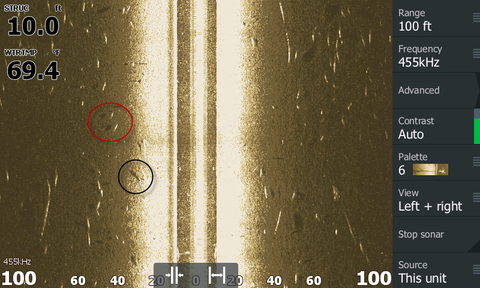Sorry, but it doesn’t work well. We can only make educated guesses.
I was looking for walleyes in the fall and noticed these nice fish at the depth I fish plus they were close to the bottom which is typical for walleyes.


But you bass anglers should read this tutorial so you can catch more fish.
I used small minnows and didn’t get bit so I up-sized to giant chubs (7 inches) and bass anglers know how much smallmouth love big minnows and I got bit. My Go Pro works well for selfies.

I decided to put down the camera to see if any walleye were mixed in and nope, just lots of bass. So, I smoked them and released them so someone else can have the same pleasure.
Watch Video of the fish
Finding fish with side imaging is difficult for most anglers since we don’t have enough screens on the boat. We tend to select map, sonar and Down Imaging and forget about the side imaging, but finding fish is easy if you have the right conditions. One of the problems we run into is that a rocky bottom reflects so much of the sonar it’s bright and fish show up as bright areas which means there is little contrast and they are easily hidden, while softer bottoms show up darker so fish really show up in this image.
Notice all the fish on the right on the first image.

I usually leave my unit on 455 kHz since you get much more range than with 800 kHz.
The next image shows larger fish in the red circle and smaller fish in the green circles. Notice the depth is 3.7 ft.

But don’t be fooled by logs on the bottom left over from the timber logging industry.
Yellow arrows are pointing out the logs.
The red circles are around fish which show up as white dots.

The next image has more fish that are longer. Here we need to remember the length of the fish is dependent on boat speed. The faster the boat travels the fewer sonar pings that are going to cover the fish so their length will show up shorter.
Another good way for identifying fish is the shadow the fish cast, the farther away the shadow is from the fish the higher in the water column the fish is located.
The red and black circles show fish and shadows. The fish nearer the center are harder to see since the bottom is brighter nearer the center so the shadow becomes helpful in identifying the fish.

I finally got to play around with the new Lowrance 3D StructureScan and used it to target suspended crappie.
The 3D display works like side can but now you can see where the fish are suspended in the water column. With side scan you can only see the fish are off to the side not where they are in the water column.
This image shows the prop wash bubbles (red circle) and the crappies suspended on the left side (green arrow).

The next image shows the crappies as history as I drive back to them. The red arrows show the prop wash bubbles and the green arrows different schools of crappie. You can rotate the screen to give these different views of the 3D live. So far I have only found it useful for suspended fish but there will be more crappie tacos for me because of this tool.

I often get questions on what fish look like on side scan at different speeds from both Humminbird and Lowrance users.

Read More >>
Knowing how to level out the StructureScan transducer is important for side scan sonar. Notice in this image it is brighter on the right side but does not see as far to the right side. The transducer is not level so the right transducer crystal is shooting more straight down than the left side. This is an easy fix by adjusting the right side a little higher. Remember that the boat is not level when you add two 250 lb anglers on one side and you leveled the transducer for just one person. I hope this quick piece helps you to understand how to level out StructureScan.
Read More >>
Learn how to get the most out of your HDS.

Read More >>
Read magazine article by Bruce Samson about structure maps. How will it help you catch more fish?

Read More >>






















